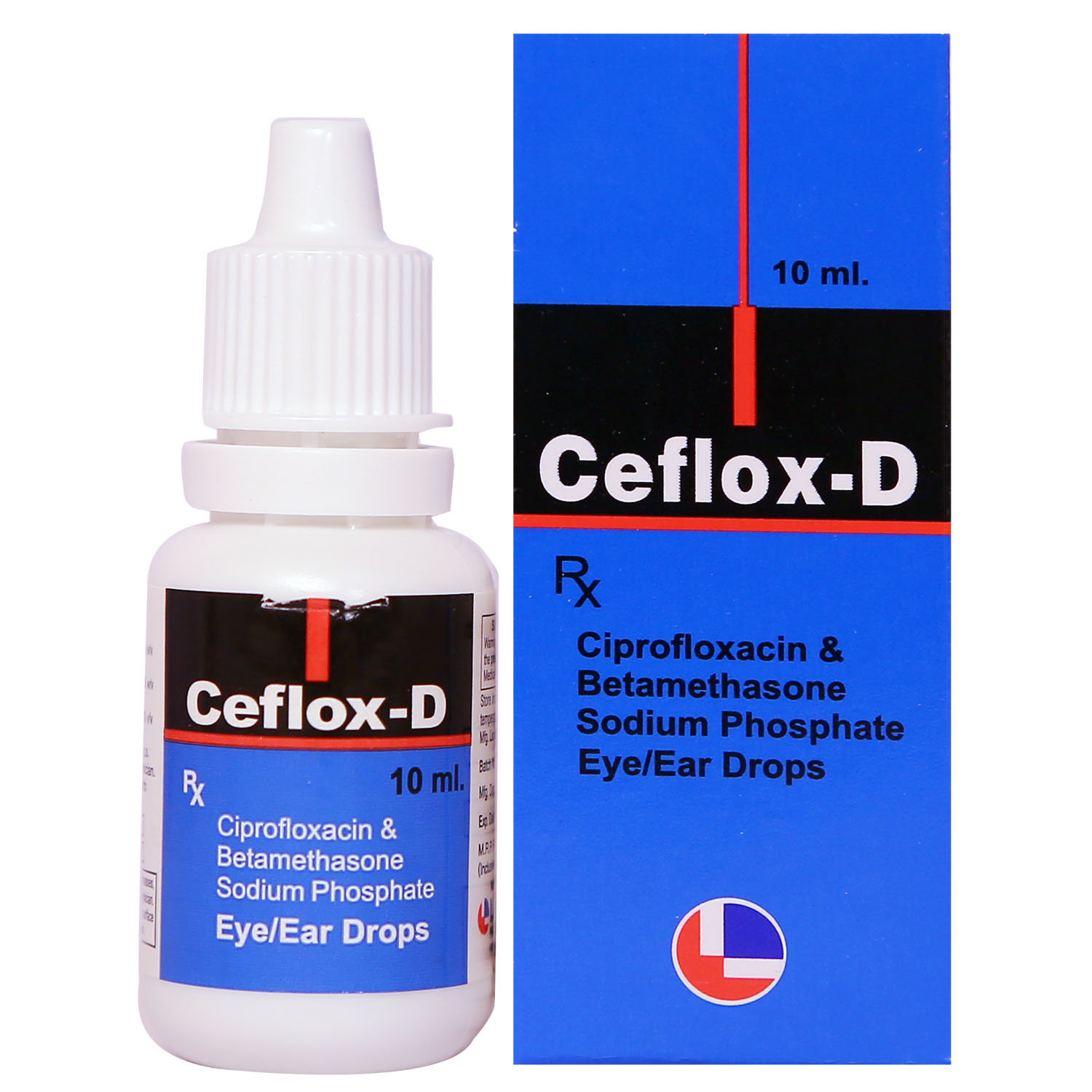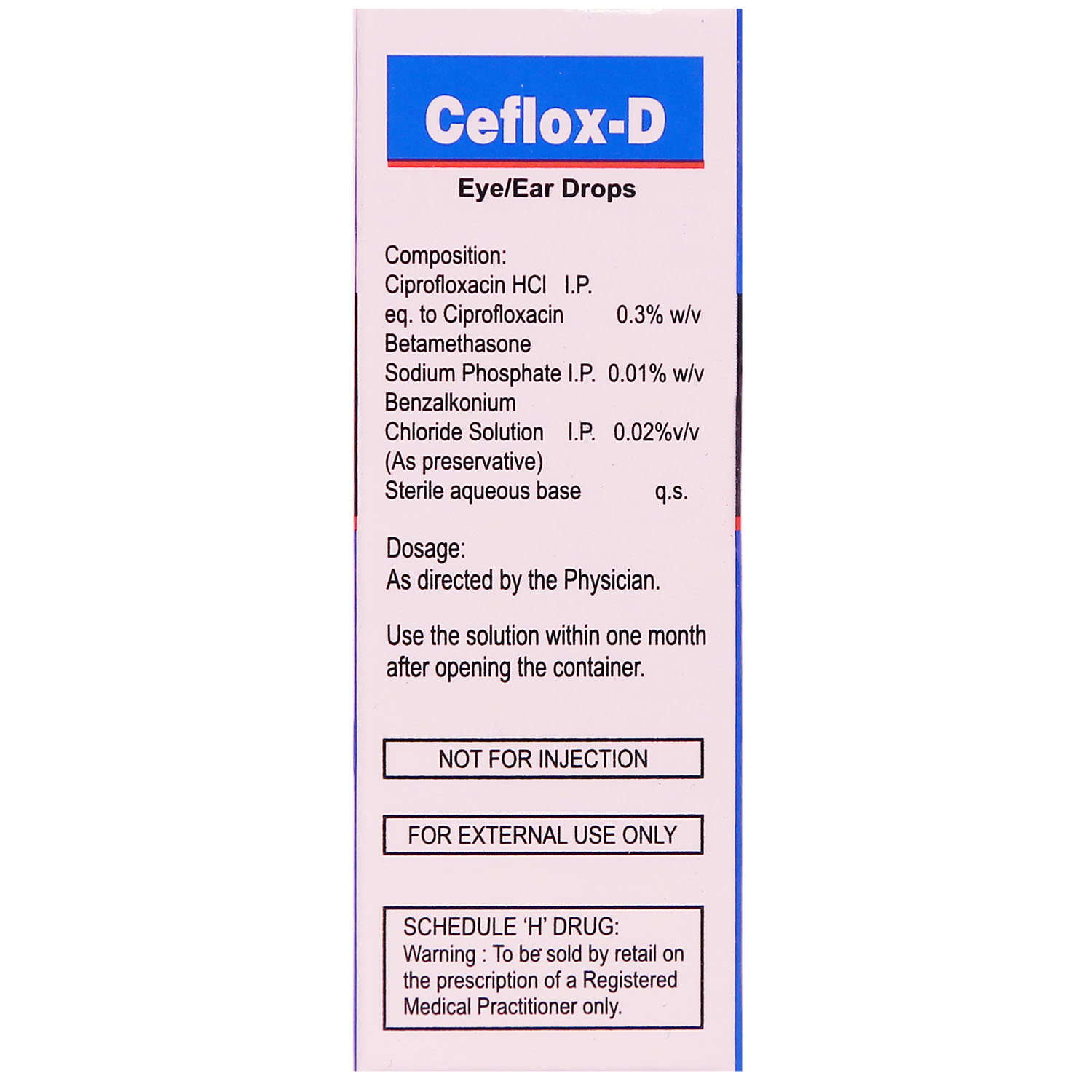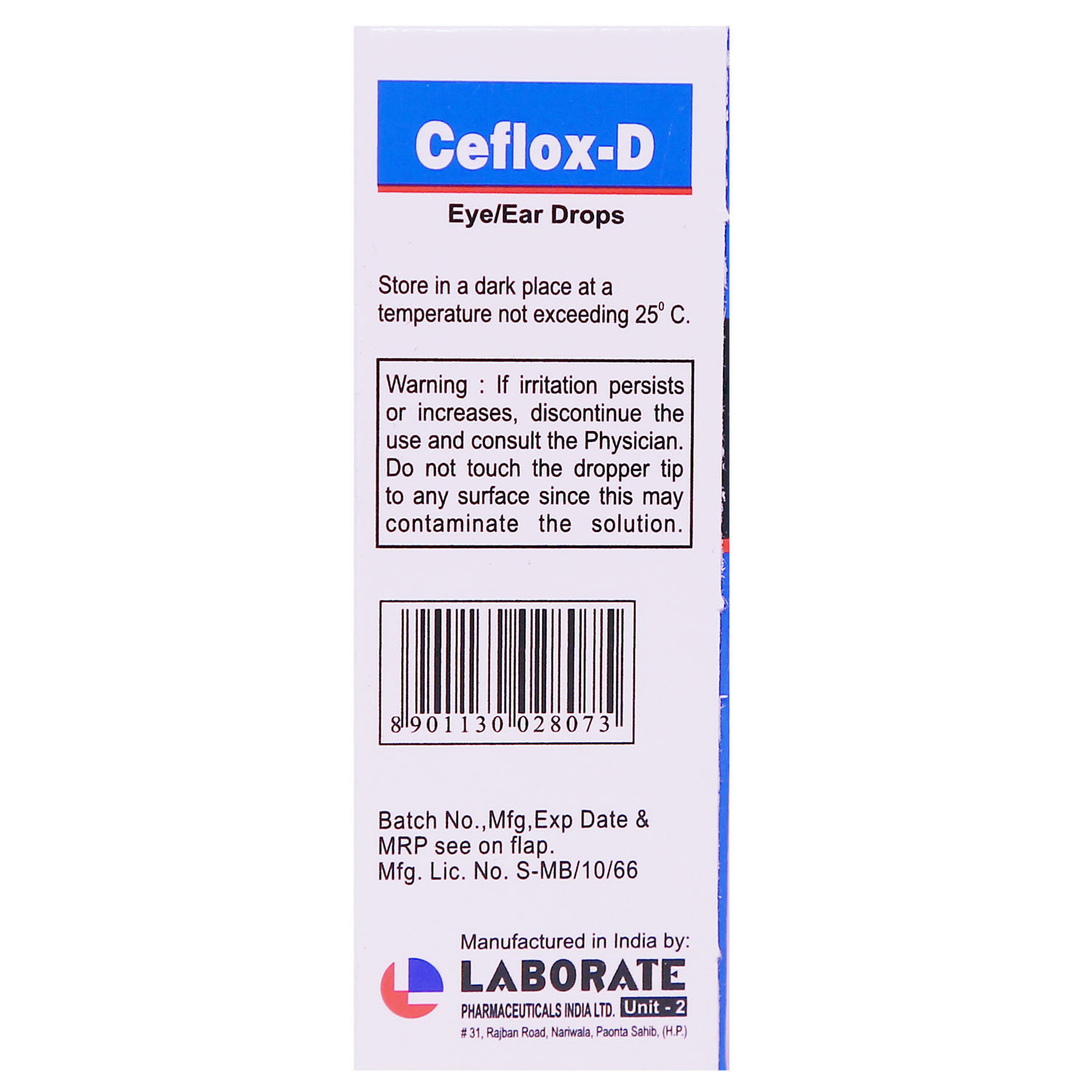Ceflox D Eye/Ear Drops



MRP ₹64.5
(Inclusive of all Taxes)
₹9.7 Cashback (15%)
know your delivery time
Provide Delivery Location
Composition :
Manufacturer/Marketer :
Consume Type :
Expires on or after :
Return Policy :

Secure Payment

Trusted by 8 Crore Indians

Genuine Products
Therapeutic Class
Country of origin
Manufacturer/Marketer address
Author Details
We provide you with authentic, trustworthy and relevant information
Disclaimer
Alcohol
Safe if prescribed
It is not known if alcohol affects Ceflox D Eye/Ear Drops. However, it is advisable not to take or limit alcohol as a precautionary measure.
Pregnancy
Consult your doctor
Consult your doctor if you are pregnant or planning for pregnancy.
Breast Feeding
Consult your doctor
Consult your doctor if you are breastfeeding. Caution should be exercised when Ceflox D Eye/Ear Drops is administered to nursing mothers.
Driving
Safe if prescribed
Ceflox D Eye/Ear Drops may temporarily blur your vision. Before driving or operating any machinery, wait until your vision has returned to normal.
Liver
Consult your doctor
Limited information is available about the usage of Ceflox D Eye/Ear Drops in patients with liver disease. Please consult your physician.
Kidney
Consult your doctor
Limited information is available about the usage of Ceflox D Eye/Ear Drops in patients with kidney disease. Please consult your physician.
Children
Safe if prescribed
Ceflox D Eye/Ear Drops is not recommended for use in children as safety and effectiveness have not been established.
About Ceflox D Eye/Ear Drops
Ceflox D Eye/Ear Drops is a combination of antibiotic and steroid medication used to treat a post-operative inflammatory condition of the eye. Besides this, it is also used to treat bacterial eye infections. Bacterial eye infection occurs when pathogenic bacteria enter any eye portion, including the eyeball, conjunctiva, and cornea.
Ceflox D Eye/Ear Drops contains ciprofloxacin and dexamethasone. Ciprofloxacin is a fluoroquinolone antibiotic that kills bacteria by inhibiting their growth. Dexamethasone is a steroid that reduces inflammation and symptoms associated with infection, such as redness and irritation. It works by inhibiting the chemicals such as prostaglandins that cause inflammation. As a result, Ceflox D Eye/Ear Drops aids in treating inflammatory conditions and eye infections.
Use Ceflox D Eye/Ear Drops as advised by the doctor. Stinging or burning sensation, gritty feeling in the eye, irritation, white deposits on the eye surface (cornea), redness and watery eyes are common side effects of Ceflox D Eye/Ear Drops. The majority of these side effects fade with time without the need for medical intervention. However, if you experience these side effects on a regular basis, you should consult your doctor.
Ceflox D Eye/Ear Drops is intended for use in the eyes; do not inject or consume. You should not use Ceflox D Eye/Ear Drops if you are allergic to ciprofloxacin and/or dexamethasone or any of the components in Ceflox D Eye/Ear Drops. Notify your doctor if you are pregnant or breastfeeding. Ceflox D Eye/Ear Drops may cause temporary blurred vision; before operating machinery or driving, wait until your vision returns to normal.
Uses of Ceflox D Eye/Ear Drops
Medicinal Benefits Mweb
Key Benefits
Ceflox D Eye/Ear Drops contains ciprofloxacin and dexamethasone. Ciprofloxacin is a fluoroquinolone antibiotic that kills bacteria by preventing their growth. Dexamethasone is a steroid that reduces inflammation and infection-related symptoms such as redness and discomfort. It acts by inhibiting the chemicals that cause inflammation, such as prostaglandins. As a result, Ceflox D Eye/Ear Drops aids in treating inflammatory conditions and eye infections.
Directions for Use
Side Effects of Ceflox D Eye/Ear Drops
- Itching
- Burning sensation
- Stinging sensation
- Irritation
- Gritty feeling in the eye
- Blurred vision
- White deposits on the eye surface (cornea)
- Redness
- Watery eyes
Drug Warnings
Do not use Ceflox D Eye/Ear Drops if you are allergic to any of its components. If you are pregnant, planning for pregnancy or breastfeeding, notify your doctor. You may notice temporary blurred vision after using this medication. Before operating machinery or driving, wait until your vision returns to normal. Before using Ceflox D Eye/Ear Drops, consult your doctor if you have vision problems, severe eye pain, glaucoma (high blood pressure in the eye), eye damage, or eye surgery. Ceflox D Eye/Ear Drops should not be used for any longer than your doctor has prescribed. Ceflox D Eye/Ear Drops should not be used to treat any other eye infections.
Drug-Drug Interactions
Drug-Drug Interactions
Login/Sign Up
Drug-Food Interactions
Drug-Food Interactions
Login/Sign Up
Tofu Set With Calcium, Ragi, Seasame Seeds, Kale, Milk, Almonds, Bok Choy, Calcium-Fortified Soy Milk, Cheese, Yogurt, Cocoa, Coffee, Dark Chocolate, Energy Drinks With Caffeine, Green Tea, Kola Nut, Tea, Tiramisu
How to manage the interaction:
Using caffeine together with ciprofloxacin may increase the effects of caffeine. Taking dairy products such as milk, yogurt, or calcium-fortified foods can make the medication less effective. Avoid taking caffeine with ciprofloxacin, as it causes effects. Contact your doctor if you experience headaches, tremors, restlessness, nervousness, insomnia, and increased blood pressure or heart rate. Avoid taking milk, yogurt, or calcium-fortified foods. You could interrupt the feeding for 1 hour before and 2 hours after the ciprofloxacin dose. Do not stop using any medications without talking to your doctor.
Drug-Diseases Interactions
Drug-Diseases Interactions
Login/Sign Up
Drug-Drug Interactions Checker List
- WARFARIN
- THEOPHYLLINE
Habit Forming
Diet & Lifestyle Advise
- Get at least six to eight hours of sleep each night to renew your eyes.
- Wash your eyes with clean water. If you have had eye surgery, wait at least two weeks before washing your eyes.
- Take care of your health, eat a balanced diet, exercise regularly, and rest well.
- Hydrate well-drink lots of water.
- Wash your hands regularly, and avoid touching your eyes with dirty hands.

Have a query?
Buy best Ocular products by
Entod Pharmaceuticals Ltd
Ajanta Pharma Ltd
Sunways (India) Pvt Ltd
Sun Pharmaceutical Industries Ltd
Cipla Ltd
Micro Labs Ltd
Allergan Healthcare India Pvt Ltd
Intas Pharmaceuticals Ltd
Raymed Pharmaceuticals Ltd
Nri Vision Care India Ltd
FDC Ltd
Jawa Pharmaceuticals India Pvt Ltd
Indoco Remedies Ltd
Sapient Laboratories Pvt Ltd
Senses Pharmaceuticals Pvt Ltd
Centaur Pharmaceuticals Pvt Ltd
Neomedix Healthcare India Pvt Ltd
Aromed Pharmaceuticals
Optho Remedies Pvt Ltd
Aurolab
Austrak Pvt Ltd
Lupin Ltd
Mankind Pharma Pvt Ltd
Zivira Labs Pvt Ltd
Optho Pharma Pvt Ltd
Synovia Life Sciences Pvt Ltd
Akumentis Healthcare Ltd
Eyekare
His Eyeness Ophthalmics Pvt Ltd
Protech Remedies Pvt Ltd
Runyon Pharmaceutical Pvt Ltd
Alcon Laboratories Inc
Syntho Pharmaceuticals Pvt Ltd
Alembic Pharmaceuticals Ltd
Bell Pharma Pvt Ltd
Klar Sehen Pvt Ltd
Sentiss Pharma Pvt Ltd
Irx Pharmaceuticals Pvt Ltd
Optho Life Sciences Pvt Ltd
Phoenix Remedies Pvt Ltd
Alkem Laboratories Ltd
Doctor Wonder Pvt Ltd
Hicare Pharma
Ipca Laboratories Ltd
Neon Laboratories Ltd
Okulus Drugs India
Pharmtak Ophthalmics (I) Pvt Ltd
Berry & Herbs Pharma Pvt Ltd
Glow Vision Pharmaceuticals
Kaizen Drugs Pvt Ltd
Choroid Laboratories Pvt Ltd
Indiana Opthalamics Pvt Ltd
Optica Pharmaceutical Pvt Ltd
Pharmatak Opthalmics India Pvt Ltd
Samarth Life Sciences Pvt Ltd
Vibgyor Vision Care
Mofon Drugs
Novartis India Ltd
Pharmia Biogenesis Pvt Ltd
Zydus Cadila
Appasamy Ocular Devices Pvt Ltd
Leeford Healthcare Ltd
Medivision Pharma Pvt Ltd
Orbit Life Science Pvt Ltd
X-Med Royal Pharma Pvt Ltd
Zee Laboratories Ltd
Aarma Laboratories
Guerison MS Inc
Laborate Pharmaceuticals India Ltd
Xtas Pharmaceuticals
Accurex Biomedical Pvt Ltd
Blucrab Pharma Pvt Ltd
Does Health Systems Pvt Ltd
Flagship Biotech International Pvt Ltd
Lavue Pharmaceuticals Pvt Ltd
Nutrilis Healthcare Pvt Ltd
Ursa Pharm India Pvt Ltd
Vee Remedies
Vyonics Health Care India Pvt Ltd
Warren Pharmaceuticals Pvt Ltd
Abbott India Ltd
Accvus Pharmaceuticals
Akums Drugs & Pharmaceuticals Ltd
Cadila Healthcare Ltd
Carevision Pharmaceuticals Pvt Ltd
Dey's Medical Stores (Mfg) Ltd
East West Pharma India Pvt Ltd
Eyedea Pharmaceuticals Pvt Ltd
Nimbus Healthcare Pvt Ltd
Ocuris Pharmaceuticals Pvt Ltd
Sherings Pharmaceuticals
Tarks Pharmaceuticals Pvt Ltd
Vcan Biotech
Vision Medilink
Aice Health Care Pvt Ltd
Appasamy Pharmaceuticals Pvt Ltd
Asperia Lifescience Pvt Ltd
Beatum Healthcare Pvt Ltd
East India Pharmaceutical Works Ltd
Grevis Pharmaceutical Pvt Ltd
Customers Also Bought




